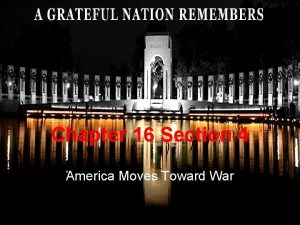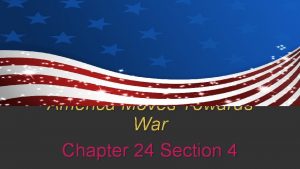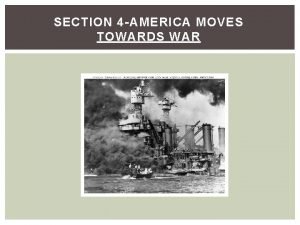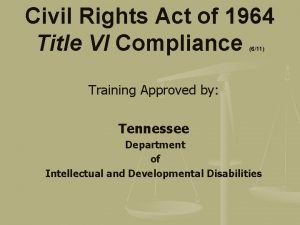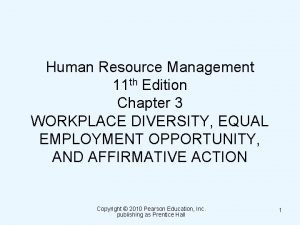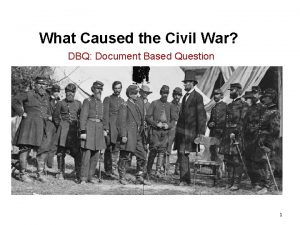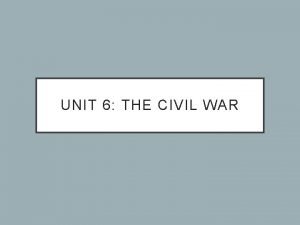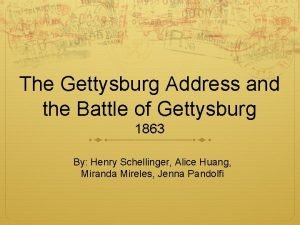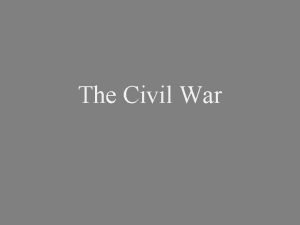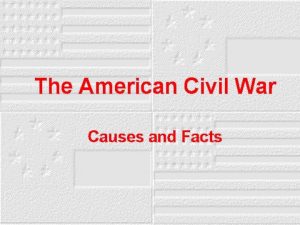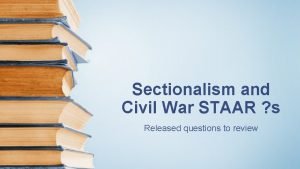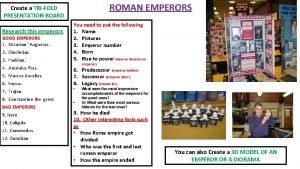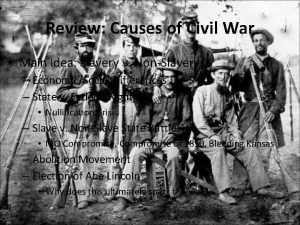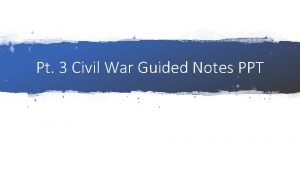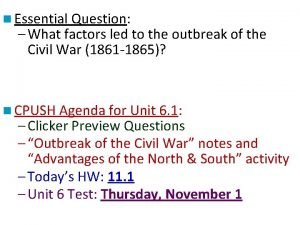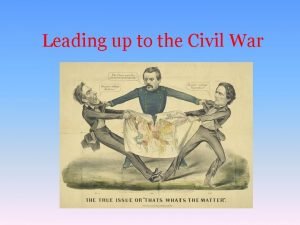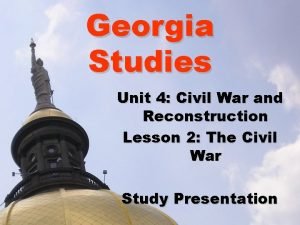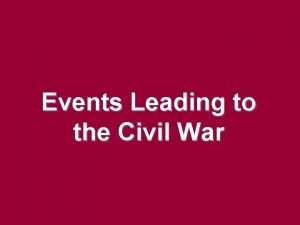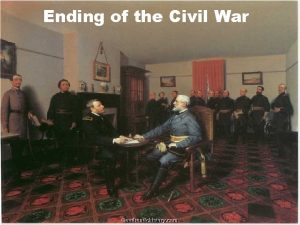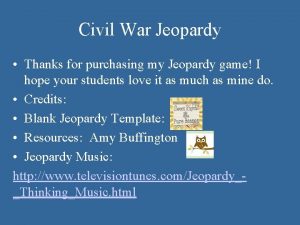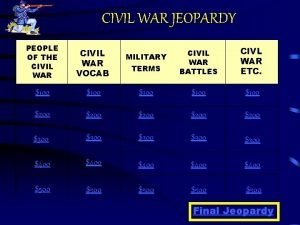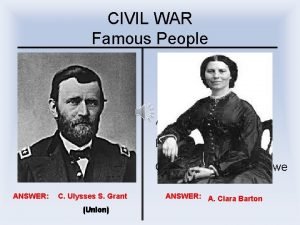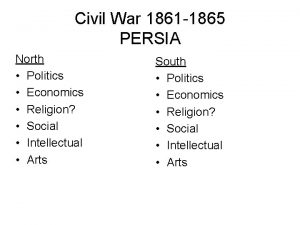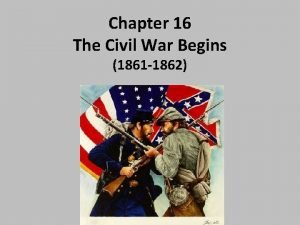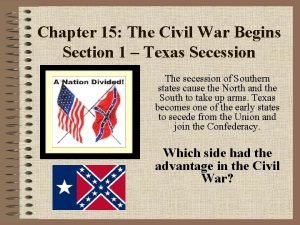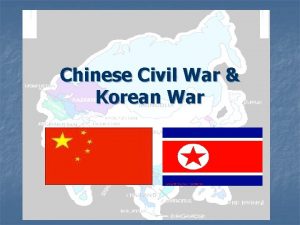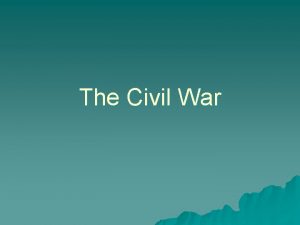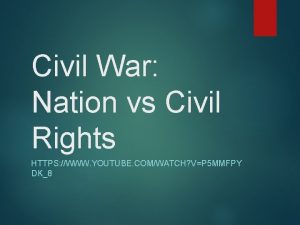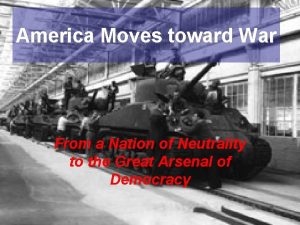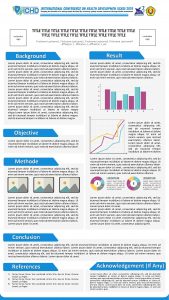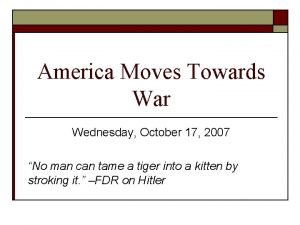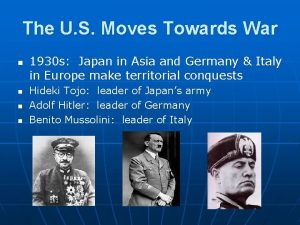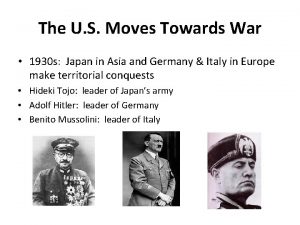Write Title The Nation Moves Towards Civil War






































- Slides: 38

Write Title: The Nation Moves Towards Civil War, 1820 -1861 Analyze Primary Sources Write Essential Question: What are the political, economical, cultural reasons of slavery and the impact of slavery that will lead America to the Civil War? This is an interactive presentation and you will turn in for credit when completed.

1. Describe setting, details, people, objects in source. 2. What’s the machine called? 3. What’s it used for? Slaves using the cotton gin to pick out seeds from the cotton. Made the process quicker, need for slaves went up

The seeds must be removed from the cotton fibers to make cloth. This process is called ginning, after Eli Whitney's cotton gin; gin is short for engine.

1. Guess how many pounds of cotton a slave was expected to pick in a day? 2. What do you notice that you didn’t expect, 3 observations? Picking cotton required many tedious hours and much back breaking labor. A slave was expected to pick at least 200 -max. 800 pounds of cotton a day and had to gin by hand, before cotton gin was invented. A slave had to fill a shoe full of seeds at night before going to bed. What’s your size shoe? Those with the biggest shoe size had to gin into the wee hours of the night to make their quota.

Map showing the distribution of slaves in the Southern States. 1. Why is this statistic important? Explain.

Entire U. S. map for explanation of slave population right before the Civil War. There were also slaves in the territories, but not shown here.

1. Why such a huge demand for slaves after the year 1790 -1860? Increased demand for cotton = increased demand for slaves… • Cause: Samuel Slater 1790 built first cotton-spinning machine. This meant that cotton could now be quickly and easily turned into yarn. • Cause: Eli Whitney invented Cotton Gin (1792 --- gin short for engine)this machine removed the seeds from cotton-- before the “gin, ” it would have taken all day to remove the seeds from a pound of cotton. • Effect: The demand for cotton increased, so the demand for slaves to pick that cotton also increased… • Effect: The demand for cotton skyrocketed, and Southern planters scrambled for land to grow cotton, and workers to plant and harvest it…

Growth of Slave Population, 1790 -1860 1. Why is this graph important and of significance to our study of slavery during this period of history? Economic, political reasons.

1. Why did the price of a prime slave field hand sky rocket way above the price of cotton per pound? Economic, cultural reasons.

1. Write in two sentences what this graph shows between the growth in the number of slaves and the growth in bales of cotton from 1790 -1860. Supply of cotton and the demand for slaves kept the illegal slave trade alive in the U. S. for economic, political, cultural benefits both in the South, North and the territories of the U. S.

Where in the Constitution is the three fifths clause 1787? Please get out pocket Constitutions now. Article I Section 2 clause 3. Let’s read it together. Legislative Powers, House of Representatives. Based on population of a state. 1. Why does the wording avoid the word “slave? ” What word is used instead? “held to service” refers to indentured servants. “Three fifths” of all other Persons, refers to slaves. Founding fathers could have had slavery abolished in 1787, however this wouldn’t have had all 13 states in agreement, to ratify (approve) the “Law of Land. ”

Where in the Constitution is the fugitive slave clause 1850, 63 years later Later changed by the 13 th Amendment, abolishing slavery ratified 1865 after C. W. ended. Article IV Section 2 clause 3. Let’s read it together. 1. Which words explain if a slave is caught what happens to them? “But shall be delivered up on Claim of the Party to whom such Service or Labour may be due. ”

Fugitive Slave Act passed by Congress in September 1850. The law provided for the appointment of federal commissioners empowered to issue warrants for the arrest of alleged fugitive slaves and to enlist the aid of 1. How does this source even civilian bystanders reflect the time period in their apprehension. in history and what details add to your answer? Notice how these men are dressed, what might this reveal about the men? 2. Write a caption/slogan for this

Explanation of primary source A group of four black men --possibly freedmen-ambushed by a posse of six armed whites in a cornfield. One of the white men fires on them. Two of the blacks have evidently been hit; one has fallen to the ground while the second staggers, clutching the back of his bleeding head. The two others react with horror. Bottom left 1 st from Bible "Thou shalt not deliver unto the master his servant which has escaped

Significance of Fugitive Slave Law to Southern and Northern states and territories in the west. 1. What is the significance, importance of this piece of legislation? 2. What is the impact of this law to the Southern states and territories? To the Northern states and territories? 1. Any free black citizen could have been captured and sold into slavery. 2. Owners of slaves are overjoyed because their fugitive (escaped) slaves legally had to be brought back. In the north a rise in the abolition movement and underground railroad.

1. What do you wonder when viewing this source? • When Slaves resisted or ran away I wonder if… from their masters, after capturing them again they would be made 3 total & make to wear this "Punishment Collar". a sketch. This made it impossible for the slave to hide in an area with trees of bushes. These collars clearly marked out a person as having run away or to be dangerous. The four spikes sticking out would have made it impossible for the wearer to lie down or to lean against any surface. Other punishment devices included muzzles or iron masks.

Read the broadside which was written and posted to capture Tom a runaway slave. 1. What are 2 reasons the details describing Tom are important? 2. What are 2 more details you would want to know about Tom?

1. What else do you observe in these sources that would be used for punishment of a fugitive slave? 2. What persuasive techniques were used in the ad to catch Robert Porter, a fugitive slave?

1. What is Lewis searching for in a free state? 2. What is the word “mulatto” mean referring to Berry’s wife? Mulatto is a “derogatory term that came into use during slavery when referring to the bi-racial offspring of African slaves and most often, their white European slave masters. ”

1. Why would Edmund have a “down look” when spoken to? On a side note…Corpulent means stout, chubby.

1. Why would Emily not have a last name? 2. What persuasive techniques were used to convey the capture of Emily?

1. Predict why Albert’s left hand might have been injured from the chop of an axe.

1. Describe details of scenery, setting, expressions, objects. 2. Why are each of these details important and of significance to this source?

1. What do you notice that you didn’t expect from this source? 2. Who would use this source besides fugitive slaves? A network of places (called stations) where escaped slaves could find help on their quest for freedom south to north to the “Promised Land” (Canada) Harriet Tubman (had a $40, 000 bounty on her head during the Civil War) and other abolitionists (or conductors), both black and white, responsible for approx. 2, 000 slaves per year reaching freedom.

Harriet Tubman became famous as a “conductor” on the Underground Railroad during 1850 s. Born a slave, she endured the harsh existence of a field hand, including brutal beatings. In 1849 she fled slavery, leaving her husband family behind in order to escape. Despite a bounty on her head, she returned to the South at least 19 times to lead her family and hundreds of other slaves to freedom via the Underground Railroad. Tubman also served as a scout, spy and nurse during the Civil War. 1. Despite dangers along the UGRR, the chance of getting caught, enduring harsh punishment if captured Harriet’s message of never giving up is revealed in this quote. Explain why should the escaped slave “Keep going, never stop, to get a taste of freedom? ”

WADE IN THE WATER-Spiritual Song UGRR Wade in the water Children wade, in the water God's gonna trouble the water Who's that young girl dressed in red Wade in the water Must be the children that Moses led God's gonna trouble the water Wade in the water, wade in the water children Wade in the water, God's gonna trouble the water Who's that young girl dressed in white Wade in the water Must be the children of the Israelite Oh, God's gonna trouble the water Wade in the water, wade in the water children Wade in the water, God's gonna trouble the water Who's that young girl dressed in blue Wade in the water Must be the children that's coming through, God's gonna trouble the water, yeah Lyrics contain coded instructions to fugitive slaves about how to avoid being re-captured. 1. In the Lyrics of the song who is Moses also referred to as the Israelite? 2. Who are the children of this Israelite?


1. What is the purpose of this source? Quilt squares were sometimes used as coded maps to help slaves escape


Code Words used by Conductors of UGRR • “A friend with friends” – password used to signal arrival of escaped slaves with their conductor • Clothesline telegraph – code used when slaves escaped, a white shirt signaled it was not safe to run, a red shirt meant “GO!” • Drinking Gourd – North Star, Big Dipper • Station – place of safety and temporary refuge, a safe house • Station Master – Keeper of safe house (many were Quaker families) • “The wind blows from the South today” – warning that slave catchers were nearby • Stockholder – donor of money, clothing, food etc.

Read about Henry “Box” Brown. 1. How did Henry Brown get his nickname?

Still and Brown worked tirelessly as Abolitionists, trying to convince Northerners and Southerners to abolish slavery in U. S. They were also conductors on the UGRR. Thomas Garrett, from his hardware store in Wilmington, which had a secret panel, he helped over 2, 300 fugitive slaves slip through the last 20 miles of slave territory into Pennsylvania.

Understanding the story of freedom in America through the UGRR • First, the institution of slavery directly contradicted the spirit of liberty that was wafting through America in the 1800 s. • Second, the Underground Railroad was a key to freedom for fugitive slaves. • Third, for the Underground Railroad to be successful, black and white had to work together—effectively and courageously.

In the 1850 s abolition (stop the institution of slavery) was not a widely embraced movement in the United States. It was considered radical, extreme, and dangerous. Frederick Douglass sought not only to convince people of the wrongfulness of slavery but also to make abolition more acceptable to Northern whites. 1. Why was the abolition movement considered radical, extreme and dangerous? To help answer this question remember the economic, political, & cultural benefits of slavery.

Even Northerners who were anti-slavery were not necessarily pro-abolition. Many were content to let Southerners continue to hold slaves, a right they believed was upheld by the Constitution. They simply did not want to slavery to spread to the U. S. territories where it did not exist. Frederick Douglas sought to change minds about the abilities and intelligence of African Americans. In 1852 many, if not most, white Americans believed that African Americans were inferior, indeed, less than fully human. You are giving a persuasive speech at an antislavery, pro abolition town meeting. Write at least 3/4 page speech persuading U. S. citizens living in 1857 -60 that America should abolish slavery now. Include: Cultural/moral impact=fugitives were people, not property. Political impact=fugitive slave law, state sovereignty/power resist federal power. Economic=federal money being used to return fugitives.

Dred • • • This reversed earlier decisions and was an enormous step back for Northern abolitionists. South was pleased with courts decision. Free blacks could be sold into slavery. • Scott Supreme Court Decision (1857) Dred Scott, a slave sued for his freedom after his owner died. He claimed that because his owner had once taken him to free states for approx. 2 years, he was entitled to his freedom. 1. What do you think the Court ruled, freedom for Dred Scott or not? The Supreme Court ruled that no one of African descent could qualify for U. S. citizenship. Slaves were not citizens and therefore could not sue. The restriction of slavery is unconstitutional because the 5 th amendment states that no one may be “deprived of life, liberty or property without due process of law. ” Slaves were property this meant that

By 1857, with 400, 000 men & women owning 4 million slaves worth over $2 billion, slavery in America had become an ingrained institution, in practice for approximately 240 years, and inseparable from the Southern economy and lifestyle.

Make this graphic organizer. Economic reasons impact of slavery 1. Free labor from slave working, cotton economy would collapse. 2. Northern textile mills would eventually fall ultimately creating economic destruction all over the nation. 3. Selling of slaves, slave trade. 4. Capturing slaves, bounty hunters. Political reasons impact of slavery 1. Representation in Congress, more votes based on population, counting threefifths of slaves. 2. Dred Scott Court decision: all blacks had no legal standing as persons in our courts, they were property, the Constitution protected slave-holders' rights to their property. 3. The Constitution “supreme law of the land” did not even mentioned “slavery. ” What are the political, economical and cultural reasons; the impact of slavery that will lead America to the Civil War? Cultural reasons impact of slavery 1. With the slaves freed, there would be widespread unemployment. This would lead to uprisings, rebellion. 2. Slavery was divine and brought Christianity. 3. Slave owners would protect and assist their slaves when they were ill and in need. 4. Slaves lack the ability to manage their own lives. Owners had power and control. A natural superiority.
 Civil war first modern war
Civil war first modern war Toward civil war lesson 3 secession and war
Toward civil war lesson 3 secession and war Loyalty and devotion to one's country
Loyalty and devotion to one's country Country vs nation
Country vs nation Nation state vs nation
Nation state vs nation Nation vs state
Nation vs state Civil rights webquest
Civil rights webquest America moves toward war
America moves toward war Chapter 24 section 4 america moves toward war
Chapter 24 section 4 america moves toward war America moves toward war section 4
America moves toward war section 4 Title vi of the civil rights act of 1964
Title vi of the civil rights act of 1964 Title vii of the civil rights act
Title vii of the civil rights act Title vii of the civil rights act
Title vii of the civil rights act What caused the civil war dbq
What caused the civil war dbq Civil war map activity
Civil war map activity Sherman's neckties
Sherman's neckties What battle was the turning point of the civil war
What battle was the turning point of the civil war English civil wars timeline
English civil wars timeline What led to civil war
What led to civil war Civil war facts
Civil war facts Civil war staar questions
Civil war staar questions Civil war trifold
Civil war trifold Conclusion of the civil war
Conclusion of the civil war Ppt
Ppt Civil war advantages and disadvantages chart
Civil war advantages and disadvantages chart What led to the civil war
What led to the civil war Civil war trading cards project
Civil war trading cards project Unit 4 civil war and reconstruction
Unit 4 civil war and reconstruction What events led to the civil war
What events led to the civil war Civil war map sherman's march to the sea
Civil war map sherman's march to the sea The civil war affected the northern economy by:
The civil war affected the northern economy by: Civil war and reconstruction study guide
Civil war and reconstruction study guide Causes of the civil war jeopardy
Causes of the civil war jeopardy What is gettysburg
What is gettysburg Famous people of the civil war
Famous people of the civil war Civil war advantages and disadvantages chart
Civil war advantages and disadvantages chart Chinese civil war resumes
Chinese civil war resumes Chapter 16 the civil war begins worksheet answers
Chapter 16 the civil war begins worksheet answers Civil war advantages and disadvantages chart
Civil war advantages and disadvantages chart







